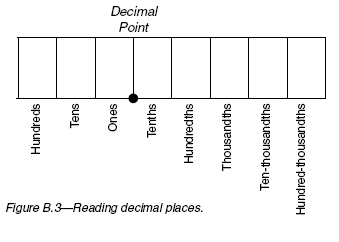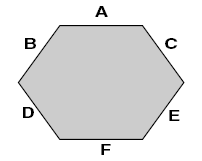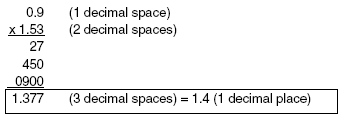1.6 Using Decimals
1.6 Using Decimals Anonymous (not verified)DECIMAL NUMBERS
How a number is read depends on where the decimal point is placed. The figure below is similar to the chart for large numbers in Section 1.1. The decimal point comes after the ones position. The numbers to the right of the decimals represent tenths (0.1), hundreds (0.01), thousands (0.001), and so on down to infinitesimally small numbers.
All whole numbers (called integers) have a decimal point at the end. For instance, 10 = 10., 24 = 24., and 17,801 = 17,801 = 17,801.0.

MULTIPLES OF 10
Decimals correspond to multiples of 10. Note that the numbers 10, 100, 1000, 10,000 and so on are written similarly except for the number of "0"s between the first digit and the decimal point. This fact allows for division using these numbers to work by simply moving the decimal place. To divide by a factor of 10, count the number of zeros in the divisor or denominator and move the decimal point that many spaces to the left.
Consider 100/10, which can be written 100.0/10.0.
There is one zero in the 10, so move the decimal point in the 100 to the left by one place. 100/10 = 10.
Example 1 - Compute 8679 ÷ 1000. There are three zeros in 1000. Move the decimal point three places to the left, remembering that whole numbers have a decimal point at the end.
We can write 8679 ÷ 1000 = 8679. ÷ 1000. = 8.679
SIGNIFICANT FIGURES AND ROUNDING FOR ACCURACY
A decimal place indicates the accuracy of the given number. The accuracy of an answer is determined by the lowest level of accuracy of the original numbers being added, subtracted, multiplied, or divided. Accuracy does not improve with addition, subtraction, multiplication, or division. This detail is especially important for performing multiplication and division with decimal places.
Example 2 - What is 8.2 + 0.25? The lowest level of accuracy is to the 0.1 (or 1/10th) decimal place, so the correct answer is to the 1/10th decimal place. Rounding up or down is a method of bringing the answer to the correct level of accuracy. 8.2 + 0.25 = 8.45. However, the answer is only accurate to the 1/10th. What is 8.45 to the nearest 1/10th? To get the answer to the appropriate accuracy, round up or round down the digit beyond the lowest level of accuracy. If the number to be rounded is 5, 6, 7, 8, or 9, round up. Round down if the numbers are 4, 3, 2, or 1.
For 8.2 + 0.25 = 8.45, round up the 0.45 to 0.5. The answer of 8.5 has the correct accuracy.
Example 3 - What is 986.525 minus 459.83?
Performing the subtraction yields the result 526.695. The lowest level of accuracy is to the 0.01 (1/100ths) decimal place, so the digit in the 0.001 (1/1000ths) place must be rounded up or down. The last digit is a 5, so we round up and express the answer as 986.525 - 459.83 = 526.70.
When adding, subtracting, multiplying, or dividing digits, all numbers must have the same number of significant digits as the least accurate original number.
Example 4 - A helicopter landing pad is in the shape of the six-sided figure below.
Side A is 12.50 feet long.
Side B is 6.57 feet long.
Side C is 7.8 feet long.
Side D is 11.00 feet long.
Side E is 5.5 feet long.
Side F is 8.15 feet long.
What is the total perimeter of the helicopter pad?

This problem involves adding numbers that are written using decimal notation.
First, set up the sum: 12.50 + 6.57 + 7.8 + 11.00 + 5.5 + 8.15 = 51.52
Now, check to see that your answer is expressed the correct accuracy. The lowest level of accuracy is the 0.1 (1/10ths) decimal place, as expressed by 7.8 and 5.5. Rounding the 0.01 (1/100ths) place digit, we express the perimeter of the helicopter pad as 51.5 feet.
MULTIPLICATION WITH DECIMALS
Accuracy in an answer is indicated by placement of the decimal point when multiplying numbers.
In multiplication, determine the correct decimal point after the multiplication is complete. After the numbers have been multiplied, count the number of places to the right of both of the original numbers. The lower amount of decimal places is then applied to the product as the number of places to the right of the decimal.
Example 5 - Multiply 0.9 × 1.53.

In this example, 1.377 has three decimal places, but the lowest accuracy number involved in the multiplication (0.9) has 0.1 (1/10ths) accuracy. Round the answer to the tenths place: 0.9 × 1.53 = 1.4
DIVISION WITH DECIMALS
When performing division, it is important to look at the dividend, which is the number that is being divided. Long division is performed by placing the decimal point in the answer directly above the decimal point in the number being divided.
Example 6 - Compute 89.76 ÷ 12

In this case, the answer 7.48 has the same number of decimal places as the dividend.
If the divisor is not a whole number, the decimal places need to be moved in both the divisor and dividend to make sure that the decimal in the quotient is correctly placed. First, move the decimal point in the divisor to the right to make the number into a whole number, or integer. Then, move the decimal point in the number being divided (the dividend) to the right by the same number of spaces. Now, place the decimal point directly above the point in the number being divided and divide as though dividing whole numbers.
Example 7 - Divide 4.067 / 0.83.
To make the divisor a whole number, the decimal point must be moved two places to the right so the divisor becomes 83. The decimal point must also be moved in the dividend, so that the dividend becomes 406.7

Now, long division proceeds as with whole numbers, and the answer to 406.7/0.83 is 4.9.
DOES YOUR ANSWER MAKE SENSE?
One tip for working with decimals is to ask yourself, "does that answer make sense"? If you are adding or multiplying whole numbers (integers), your end result should be larger then the numbers being multiplied. If you are subtracting or dividing whole numbers (integers), your result should be smaller. We can do a quick check of the division involving decimals in Example 7 by the looking the numbers being divided. In this case, we are dividing a number slightly larger than 4, by a number slightly smaller than 1. We can compute that 4 ÷ 1 is 4, so our number should be somewhat close to that. It should not be 40, or 0.4, or 400. In doing calculations in the field, look carefully at the numbers involved, and the operation (addition, multiplication, etc.). In many situations, the answer can be imperative to your safety, so make sure that the end result makes sense.